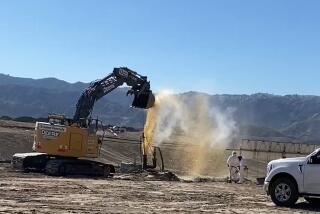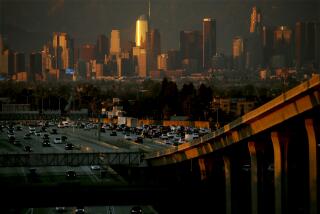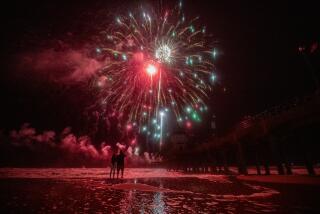Along with beauty, fireworks create a beastly mix of pollutants

When the rockets and the bombs burst in the air tonight, spectators will experience more than a spectacular show celebrating America’s birthday.
When their blends of black powder, metals, oxidizers, fuels and other toxic ingredients are ignited, traces wind up in the environment, often spreading long distances and lasting for days, even months.
Although pyrotechnic experts are developing environmentally friendly fireworks, Fourth of July revelers this year will be watching essentially the same high-polluting technology that their grandparents experienced decades ago.
Throughout the Los Angeles region, concentrations of fine particles, or carbon soot, skyrocket for up to 24 hours after the Independence Day shows, reaching levels as high as those from wildfires.
Public health officials warn that people with heart problems or respiratory diseases, such as asthma, should avoid the smoky celebrations, staying upwind or indoors.
“I enjoy a fireworks display as much as anyone else, but we do have concerns about exposure to high levels of smoke and particles,” said Jean Ospital, health effects officer for the South Coast Air Quality Management District.
Also, traces of poisonous metals, which give fireworks their bright colors, and perchlorate, a hormone-altering substance used as an oxidizer, trickle to the ground, contaminating waterways.
One Environmental Protection Agency study found that perchlorate levels in an Oklahoma lake rose 1,000-fold after a fireworks display, and they stayed high in some areas for up to 80 days.
European chemists Georg Steinhauser and Thomas Klapotke wrote in a recent scientific journal that “several poisonous substances are known to be released in the course of a pyrotechnic application” and that they are dispersed over a large area.
“It is clear from a vast array of studies that traditional pyrotechnics are a severe source of pollution,” they wrote.
The black powder, or gunpowder, used in most fireworks has an extremely high carbon content; when ignited, it fills the air with fine particles capable of inflaming airways and lodging in lungs.
Every July 4 and 5, the Los Angeles region suffers “generally poor air quality for particulates,” said Philip Fine, the AQMD’s atmospheric measurements manager.
Particulates can cause coughing, sore throats and burning eyes. For people with asthma or other respiratory or cardiovascular conditions, the effects are much worse. Hospital admissions and deaths from asthma, heart attacks and respiratory disease increase whenever particulate levels rise.
In the areas around fireworks displays, particulate levels increase about 100-fold and don’t return to normal until around midday on July 5, according to AQMD data.
During a fireworks show in Indio in 2004, particulate measurements peaked at 847 micrograms per cubic meter of air, nearly six times the federal health standard. Particulate readings are averaged over a 24-hour period, so that was not technically a federal violation.
Metals in the air also surge, although they do not exceed state health guidelines. Nonetheless, they build up in waterways and soil.
Ironically, green-colored fireworks are the least “green” because the metal that produces the color, barium, is highly poisonous.
Scientists in India found that airborne barium increased by a factor of 1,000 after a huge fireworks display there. Strontium, which creates red, and copper, which forms a blue hue, can also be toxic.
“The use of heavy metals like barium or strontium should be reduced or, if possible, avoided,” said Karina Tarantik, a chemist at the University of Munich in Germany whose lab is working on cleaner pyrotechnics.
Much of the new research has been propelled by concern over perchlorate, which has been used since the 1930s to provide oxygen for pyrotechnic explosions.
Perchlorate, which has contaminated many drinking water supplies from military and aerospace operations, can impair the function of the thyroid gland by blocking the intake of iodide. Fetuses are most at risk, because thyroid hormones regulate their growth.
Scientists have made significant advances in low-smoke and perchlorate-free technologies, prompted by the military, which uses flares and other pyrotechnics, and by Walt Disney Co., which stages about 2,000 fireworks displays a year.
In the late 1990s, Disney approached the Los Alamos National Laboratory with a request to develop cleaner fireworks to reduce smoke at Disneyland, which was prompting complaints to the AQMD from neighbors in Anaheim.
Instead of carbon-based materials, scientists there experimented with nitrogen atoms, which produced far less soot and smoke.
“In addition, because the high-nitrogen materials burn more cleanly, you could use less coloring agents. We were able to get much nicer colors with . . . less metals,” said David Chavez, a materials chemist at Los Alamos.
Based on those experiments, Los Alamos chemists Michael Hiskey and Darren Naud took an entrepreneurial leave and founded DMD Systems.
Their fireworks use nitrocellulose, which is inexpensive and plentiful, and they emit water, nitrogen and carbon dioxide instead of smoke and perchlorate, Hiskey said. The metal content has been reduced by about 90%, he said.
The cost is about the same as for other U.S.-manufactured fireworks. Disney World in Florida has used his company’s comets for about six months.
Disneyland developed aerial launchers that replaced black powder with compressed air in 2004. The resort puts on more than 200 fireworks shows each year, burning about 60,000 pounds of fireworks, far more than all the other theme parks and stadiums in the region combined.
“Now we’re on a path toward creating the next generation of fireworks,” said Disney Imagineering spokeswoman Marilyn Waters.
She said that other ultra-low-smoke and perchlorate-free technologies are already used in some Disney shows in Anaheim, Florida and Hong Kong and that an international team of vendors and scientists is testing more innovations.
But municipalities and civic groups, which buy inexpensive fireworks from China, can’t afford the cleaner ones for their Independence Day celebration. So far, they cost about 10 times more than the Chinese-made ones.
“Everything they get is from China,” Hiskey said. “It’s going to be very difficult to break the China habit.”
But John Conkling, an adjunct professor of chemistry at Washington College in Maryland and former executive director of the American Pyrotechnics Assn., is confident that environmental concerns are driving the industry.
“Certainly if we can replace perchlorates, the world will be a better place,” he said.
“I’m optimistic that we will have fireworks shows down the road with much less perchlorate, if any, and we’ll still have the spectacular shows we’ve always had,” Conkling said. “I expect even by next season there will be less perchlorate in fireworks. Within a five- to 10-year period, we’ll see major, major changes.”
In the meantime, Hiskey has some Fourth of July advice: Where there’s smoke, there are toxic substances.
“If I’m having trouble seeing things because it’s so smoky, if the smoke is headed toward the crowd, that really stinks,” he said.
RELATED STORYA list of Independence Day festivities across the county. Page B3
More to Read
Start your day right
Sign up for Essential California for news, features and recommendations from the L.A. Times and beyond in your inbox six days a week.
You may occasionally receive promotional content from the Los Angeles Times.






